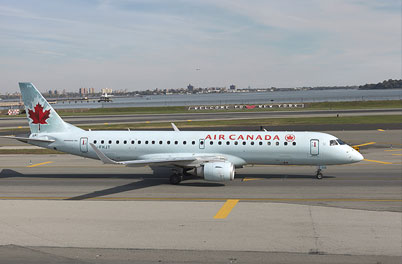I debated whether I was going to write this post long before I ever flew in one, and I eventually decided not to. But then HB posted a comment on yesterday’s article about high fares to visit Canada. I guess I don’t have a choice!
My wife and I recently flew SEA – YYZ – SEA and we were actually really happy with the E190, mainly due to the 2-2 seating configuration. Given that you can also put full sized carry-ons in the overhead bins, I feel the E190 doesn’t really deserve to be put in the same category as other regional jets.
If I were given a choice to fly on a single aisle conventional narrow body (A320/B737/B757) or a E190, I think I would pick the latter every time (no middle seats!). The E190 also appeared to have much bigger windows, which is a nice bonus for aviation geeks who like to look outside.
We also didn’t find the seats noticeably smaller – I cross-checked with routehappy which actually indicated the seat pitch is greater than standard at 33″.
Curious to hear more about why you didn’t like the E190!
First of all, I am not an avgeek. I think planes are cool, but I’m not going to be memorizing stats anytime soon. I’m horrible at looking out at the tarmac and identifying a plane just from appearances unless it’s something obvious (like a Boeing 747) or something I’ve flown on quite a bit. I’m basing my verdit more on general impressions as a customer than on anything technical or official.
One of the best mainline comparisons for the Embraer E-190 is the Airbus A319 (and I’ll use United’s A319 because I spend much more time on them than Air Canada’s planes). The E-190 is actually a little longer but significantly narrower and only has 2-2 configuration in economy class instead of 3-3. First/business class has a 1-2 configuration instead of 2-2. In terms of seating configuration, the E-190 is similar to other regional jets that I’m used to, including those with premium cabins like United’s Canadair CRJ-700s.

The cramped space makes me think “regional jet” even before looking at seat count. United’s A319 is configured to hold 120 total passengers while Air Canada’s E-190 is configured to hold 93 total passengers. That’s a 22.5% reduction in passenger capacity. And don’t forget that United’s A319 include EconomyPlus seats with extra leg room, so they may not be using their space as efficiently.
It felt smaller walking around the cabin of the E-190. The lavatory felt smaller. My bag had to go in sideways in the overhead compartment (though I will admit this is the first “regional jet” I’ve seen that will fit a 22″ bag at all). Seat width on the E-190 and the A319 are both 18 inches, and the lack of a middle seat is nice, but these positive comparisons don’t change the fact that it felt small. I always prefer larger aircraft, especially a wide-body Boeing 777 or 747, not necessarily because the seats are any bigger but because the extra volume makes me less claustrophobic.
(HB’s comment about seat pitch is actually a mark against Air Canada in my particular situation because, when I fly with United on an A319, I can expect a 35-inch seat pitch in EconomyPlus. Everyone on Air Canada is stuck with 33 inches.)
Finally, Embraer markets the E-190 as a separate aircraft type now, but when originally announced it was still part of the ERJ family of regional jets. That original classification is telling. The E-190 is a great regional jet, no doubt about it, but I don’t think I’m willing to include it in my list of mainline jet aircraft.
So there you have it. It is mostly my perception. It feels small, and it is small despite its other merits. Not so small as one of the dinky ERJ-145s that United likes to fly out of Houston, but it is not a standard jet either. It’s a good choice to serve routes with limited demand that don’t fit either category well. I’m still going to think of it as a regional jet, however, and would prefer not to fly them on longer trans-continental routes.

